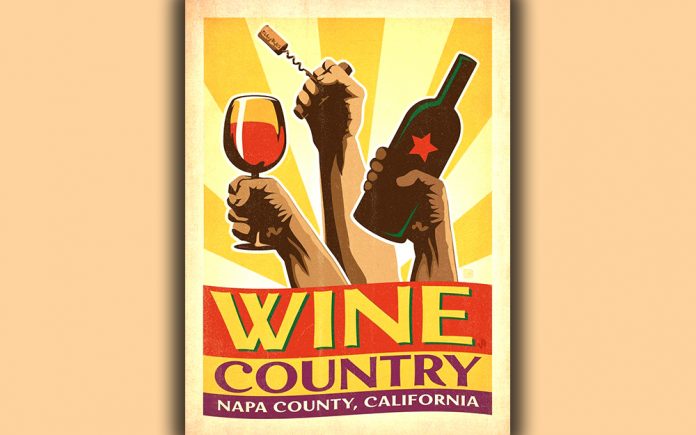
By Rick Riozza
This column has from its inception focused on the interests and concerns of anyone who desires to choose wine intelligently, to use it gracefully, and to simply enjoy and have fun with the product we’ve chosen for quaffing and for meals. And we have coined it—playing the game of wine.
You readers have been in on this game with me for some time now; I thank you for your kind emails and your continued support in reading on a subject that we’d really rather be tasting! What we’ve especially noticed over the eight years or so of publishing is the coming on-board by the new vino enthusiasts of millennials and centennials.
Millennials are now buying more wine than any other age group, which include the Baby Boomers and those Generation X,Y & Z. And the Centennials—people under 25, currently represent more than 50% of the world population. I guess, that being said, we’re looking to a real game changer sooner than later in the ethos of wine.
So cheers to the New Year and new decade ahead—and as you always allow me to do, let me just ramble on with some wine expectations on the new horizon.
Is Prosecco the New Pink? There’s nothing hotter in the wine game than a rosé or a Prosecco. In the past eight years both of these styles and type of wines has soared on popularity. How much more rosés and Proseccos are you purchasing these days?
Nearly 200 producers of Prosecco in Italy make a rosé sparkling wine. Many of the Italian rosés are out on our shelves right now—but, they can’t legally call it Prosecco Rosé yet! However, the fusion of two big trends could become official in 2020 following a lengthy approval process in Italy.
And I think we’re going to see Rosé Prosecco or Prosecco Rosé all over the place. But what’s it going to taste like?!! Folks love Prosecco because the Glera grape has its own flavor profile of apples, pears, citrus, and those subtle acacia honey and flowers, elderflower, lily, and daisy notes dancing around. The rosé part will no doubt come from the Italian Pinot Nero grape (aka Pinot Noir for us Americans)–but won’t that have a cherry strawberry influence over those subtle dancing notes?
Honestly, I think it will: red fruits dominate over floral ones. Okay—so obviously it won’t be that clunky. Big time big money winemakers will find the sweet spot by limiting the amount of Pinot Noir in the mix. However, currently, I don’t think the Ruffino Sparkling Rosé tastes at all like a Prosecco; it tastes like—well, a rosé.
Speaking of rosés, guess who just bought Chateau d’Eclans—makers of the wildly popular Whispering Angel and the new Palms Rosé that is targeting the young wine set at a cheaper price in order to get them to buy-up to the more expensive Whispering Angel when their tastes elevate. So the buyer is Moët Hennessy. That’s right! The billion dollar production and marketing operation will no doubt take those Rosés to angelic heights: T-Shirts and televisions—you never know.
Chardonnay: Are you in or are you out! A couple of years ago or so, this column wrote “Buttertown U.S,A” where we said, “the Chardonnay flavor profile has ebbed and flowed from fruity to oaky, crisp to buttery, back & forth, and up & down, is now all over the charming Chard map!
So many folks love Chard, so many folks hate it: like the “ABC Club”—Anything but Chardonnay! But it’s the largest selling varietal in the world—it beats out Cabernet Sauvignon and Pinot Noir, and it will continue to sell out in all departments in the next decade. For as many companies now making an un-oaked Chard (the fresh fruit, somewhat acidic style), there’s a move again to the strong buttery-type—the kind we thought was over as being too heavy.
Maybe we were just “closet Chardonnay” lovers. We claimed to love the fresh—but we really wanted the butter after all. And we like the balance too. Look to Eden Road, Stag Leap’s Karia, Au Bon Climat Los Alamos, Cakebread, Far Niente Napa Valley Estate.
Great Britain has noticed the sales of appassimento wines from Italy (the style where dried grapes are used in the fermentation process) have nearly doubled and were taking share from easy-drinking Argentinian Malbec wines. We know both styles of those wines being full-on with dark fruity flavors. The appassimento, however, really shows more complexities. Costly high-end Malbecs do show great complexity; inexpensive appasimento Valpolicella, and, Primitivo can do well, costing a lot less.
Austria may be best-known for its Grüner Veltliner, and, it’s finally starting to gain in popularity here in America. If you haven’t enjoyed a glass of this refreshing dinner wine yet, I recommend going over to Johannes Restaurant in Palm Springs. Johannes Bacher, born in Austria, is one of the top chefs in our valley and his cuisine is absolutely fresh, inventive, and so delicious. I’m always recommending this restaurant to the tourists who come in my wine department. And his wine list, that features many Grüners, is stellar! Check out his menu at johannespalmsprings.com.
If the Palm Springs Wine Festival, held last month at the Ace Hotel, alerted us to anything, it’s that “natural wines” are as tasty as one can imagine. And I’ve never seen such a huge crowd so enjoying these wines. As they say, “The wine future is now!” You vino lovers can find many of the wines poured there being served at the Dead or Alive wine bar in Palm Springs.
Wine topics that this column has commented on in the past year, especially that of climate change, tariffs and trade tussles, wine in cans, hard seltzer headaches, and on-line alcohol sales will continue to dominate in the new decade.
So the game is afoot, the mind is abreast, and the door is ajar—enter in and play the game with us. Cheers! Contact Rick at winespectrum@aol.com











































